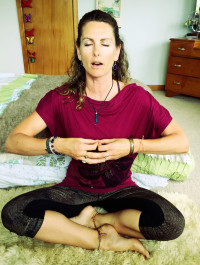by Kara-Leah Grant
Today was Day 300 of a Tantric yoga practice I’m doing, which got me reflecting on what it takes to commit to yoga.
Every day, no matter what, I sit and do this particular yoga practice, which consists of seated spinal rotations with pranayama, chanting with visualisation and mudra, and meditation.
My intention is to do 1000 days in a row – that’s almost three years of dedicated, committed practice. If I miss a day, I have to start again on Day 1.
It’s taken me over fifteen years of yoga practice to get to this point – to have enough conviction and faith to commit to a 1000 day practice.
Over the last seven years, I’ve done multiple Forty Day practices, including Sodarshan Chakra Kriya, a heart-opening kriya, a loving-kindness mediation and a practice for infinite energy and prosperity. I’ve also done a handful of 90 day and 120 day practices.
This year, I felt ready to finally take the next big step – 1000 days.
Of course, I didn’t start with that… I started by committing to Forty Days of my Tantric Meditation. At the end of Forty Days, I extended it to 90, and then 120. Finally, at 120, it was already a given that I was going to go for gold – I was heading for 1000 days.
Patanjali talks about effort and commitment in the first chapter of the Sutras, in 1.19 – 1.22.
He identifies that there are two kinds of people practicing yoga – those who have done so much practice in past lifetimes that states of samadhi (bliss and realisation) come easily to them. And then there’s the rest of us.
For the rest of us, Patanjali names five key attitudes and goals which helps us stay the course. These are:
- Shraddha: Developing the faith that you are going in the right direction
- Virya: Committing the energy to go there
- Smriti: Cultivating memory and mindfulness
- Samadhi: Seeking the states of samadhi
- Prajna: Pursuing the higher wisdom
(Source: Swamiji.com)
Knowing what practice to choose to commit to is the first step – and the biggest step! That’s having the faith that you’re going in the right direction (shraddha).
Generally, we’ve given our practices by our teachers, who can see what our tendencies are and what kind of practices we might need to balance out those tendencies. Left to our own devices, sometimes we’re more likely to choose practices which exacerbate aspects of the ego rather than dissolve them. (Witness Type A personalities pouring themselves into Bikram twice a day.)
The practice I’ve chosen to work with was given to me by Christopher Tompkins on my 200hr Teacher Training with Shiva Rea. Christopher is a Tantric Scholar and he taught us Tantra philosophy and practice on the training. (Kashmier Shaivism Tantra is not to be confused with neo-Tantra, which is concerned primarily with Sacred Sexuality).
Over the last five years, I’ve sporadically worked with this particular practice and so already had a degree of familiarity with it. Ever since I was given it… I’ve had a tugging to do it daily for a long period of time. After the teacher training, I was consistent for about six months.
This year, I knew I was ready to do the 1000 Day commitment – what Patanjali calls shraddha.
The other major factor supporting me in this decision and giving me the energy to go there (virya) was my already-cultivated habit of getting up at 5:30am.
In January of 2015 I’d done a Forty Day 5:30am practice which had revolutionised my life. I’ve always wanted to get up early, but in my early days of parenting I grabbed sleep whenever I could.
Now my son was finally five years old, I knew I had no more excuses. It was time to get up at 5:30am, every day. Establishing that routine first meant that I had the time to fit in my practice before breakfast. The practice is fluid, and can be completed in twenty minutes or extended out to take hours if so desired. Generally, I do it in 50 minutes.
Those years of doing forty day practices had also honed my memory and mindfulness around practice (smritit).
Through the various Forty Day practices I’d done over the years, I’d determined that doing a purely asana-focused practice could actually negatively impact my teaching, if it meant I wasn’t doing as much meditation, pranayama and sahaja (spontaneously arising) vinyasa.
Conversely, pranayama and meditation practices improved my teaching enormously. I knew that this particular Tantric practice would cut straight to the core of presence, and be the best possible route to Samadhi.
Finally, I wanted to pursue the higher states of wisdom (Prajna). I wanted to know who I could become if I dedicated myself to 1000 Days of the same practice.
It’s said that when you do this, you master the practice, and I wanted to know what it truly felt like to master a particular practice. I want to be as wise as I could be, and this seemed like the appropriate action to take in pursuit of this higher wisdom.
Now, I didn’t know about this particular sutra of Patanjali’s until today. I certainly didn’t know it when I was contemplating committing to a 1000 Day practice. But now, reading the sutra, it makes so much sense. All the elements he names were there, in me, just ready for a serious yoga commitment.
All those elements may be there in you too, however, that doesn’t mean you need to commit to a 1000 day, 50 minute Tantric practice.
In Sutras 1.21 and 1.22, Patanjali outlines the nine different levels of practice and commitment.
In essence, there’s a level for everyone, even a brand new beginner to yoga without much time or conviction.
This is the great thing about the yogic texts. Often, they may not make much sense until you’re at a particular point in your journey. And then, reading the text is like shining a light onto your path. You can see where you are, and even better, you can see where you’re going. No more fumbling in the dark, or wondering if you’re even on a path.
Patanjali’s nine levels of practice are all a mixture of intensity plus conviction, each rated mild, medium and intense.
For example, beginners might have mild intensity (hitting the yoga mat at home once a week) and mild conviction (thinking that maybe this might help the body or mind a little bit).
I would say my level of intensity is medium – I practice daily from between 20 minutes to two hours. But my conviction is intense. I know that practice is the most important thing in my day and I know how powerful it is.
Conversely, there are people out there doing intense physical practices – a couple of hours every day – without much conviction as to the deeper nature of yoga. This isn’t a lesser way to practice, it simply has a different result.
The important thing to remember is that it doesn’t matter which of the nine levels of practice you’re currently experiencing – all those levels progress, however softly and slowly. And that’s the key. Progress. Softly softly, year by year.
I didn’t start my 1000 Day practice the first time I tried yoga, back in 1996. It took about 19 years before I was ready to dive in and make that commitment! Wherever you are in your practice is perfect for you – the key is to commit at that level, whatever that looks like, for you and your life.
Out of that, and cultivating the five attitudes of effort, all else arises.
And if you so desire, maybe in 19 years, or 10 years, or 2 years, you’ll find yourself on a 1000 Day practice too.


Very inspiring, Kara-Leah! I’m over 400 days straight with my language studies so I know how good it feels to really commit to a long-term endeavor like this.
But I never thought about putting together a 1000-day practice. I’ve done plenty of shorter ones.
Thanks for opening my mind to it!